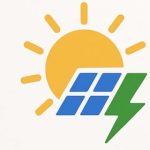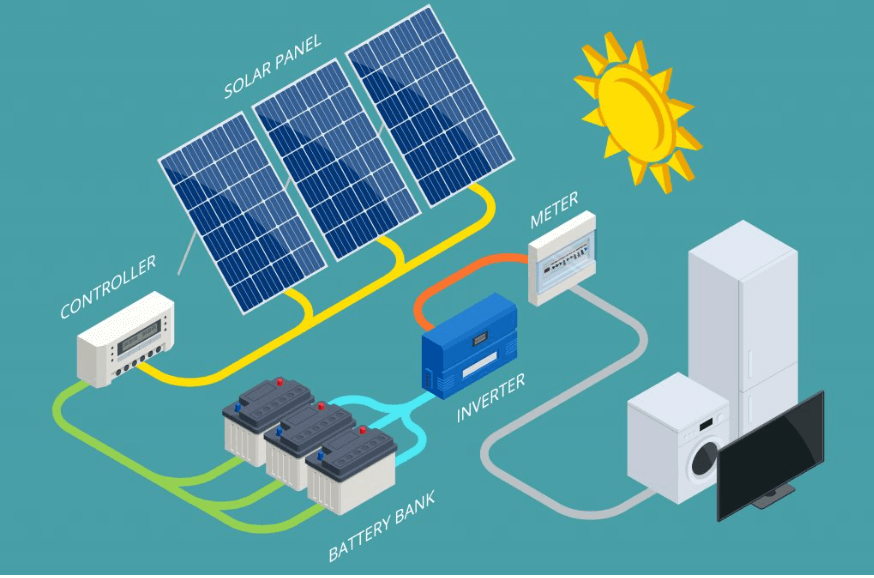Solar energy is one of the most promising and rapidly expanding sources of renewable energy. In simple terms, solar energy is the power we derive from the sunlight, which can be converted into usable electricity or heat.
Over time, technologies have improved so that solar energy is no longer just a niche or futuristic concept.
It’s a viable and increasingly cost‑effective option for homes, businesses, and utility-scale energy systems.
In what follows, I’ll explain in detail how solar energy works, the components involved, benefits and challenges, and practical considerations. Along the way, I’ll weave in parts of my own experience to make it clearer and more grounded.
Why Solar Energy Matters
Before diving deep into the mechanics, it helps to understand why solar energy is so important:
Clean & renewable
Solar energy doesn’t produce greenhouse gases or air pollutants during operation, unlike burning fossil fuels.
Abundant resource
The sun provides an immense amount of energy. In fact, the amount of sunlight that reaches Earth in about 90 minutes is enough to meet global energy demand for an entire year.
Energy independence
Using solar power allows individuals, communities, and countries to reduce reliance on external energy sources.
Cost declines
Over the past decades, the cost of solar panels and associated systems has dropped dramatically, making them more accessible.
Decentralization
Solar systems can be installed on rooftops, in rural areas, or incorporated into building designs, enabling distributed generation.
Given all that, the key question becomes, “How exactly does solar energy get turned into electricity we can use?”
The Science Behind Solar Power: The Photovoltaic Effect
At the heart of most solar electricity systems is the photovoltaic (PV) effect. Here’s a simplified breakdown of how it works.
Sunlight (photons) hits the solar panel
The sun emits electromagnetic radiation (light). When the sunlight reaches solar panels, photons (particles of light) strike photovoltaic cells.
Excitation of electrons
Inside the PV cells (often made of silicon or other semiconductors), the energy from photons frees electrons from atoms, creating electron–hole pairs.
Current flows (Direct Current, DC)
The freed electrons move through the semiconductor structure, generating a flow of electric current (DC). That is, the system produces direct current electricity.
Conversion to Alternating Current (AC)
Because most homes and appliances run on alternating current (AC), an inverter is used to convert the DC electricity into AC.
Usage, storage, or grid interaction
Once converted to AC, the electricity can be consumed immediately, stored in batteries, or sent to the electrical grid (if the system is grid-tied).
- If excess energy is produced, it can often be sold back or credited via net metering.
- On cloudy days or at night, stored energy or grid energy can supply the demand.
This process is the backbone of how photovoltaic solar systems operate.
Components of a Solar Energy System
To make the above happen reliably, a solar energy system is composed of several key pieces.
Solar Panels/Modules
These are the units you often see installed on rooftops. Each panel is made up of many solar (PV) cells arranged in series/parallel to achieve desired voltage/current. The sunlight strikes them, and they convert photons into DC electricity.
Inverter
The inverter is the component that transforms DC to AC electricity. Without it, the electricity from panels can’t be used in standard household systems. Some systems use a central inverter; others use microinverters (one per panel).
Mounting Structure
Panels must be securely mounted on roofs or ground structures, usually oriented and tilted for optimal sun exposure.
Some systems even include solar trackers that orient the panels toward the sun throughout the day to maximize output.
Electrical Wiring and Protection
Just like any electrical system, wiring, fuses, disconnects, circuit breakers, and safety devices are necessary to connect panels, inverters, your house, and possibly the grid.
Battery Storage (optional but common)
If you want to store energy for use when solar isn’t available (like at night or during cloudy periods), you include batteries in the system.
The inverter/charge controller directs excess energy into the battery and draws from it when needed.
Metering / Grid Interface
For grid-connected systems, a bidirectional meter or net meter tracks how much electricity is drawn from or sent back to the grid. This interface ensures the system harmonizes with the wider utility network.
Types of Solar Technologies
While photovoltaic (PV) systems are the most common, “solar energy” can mean other technologies as well:
Solar Thermal / Concentrated Solar Power (CSP)
Uses mirrors or lenses to concentrate sunlight to heat a fluid, which then drives turbines to generate electricity.
Solar Water Heating / Passive Solar Heating
Uses sunlight to heat water or spaces directly, useful for homes and buildings.
Passive Solar Design
Architectural techniques (e.g., large south-facing windows, thermal mass materials) to harness the sun’s heat for passive heating without mechanical systems.
Hybrid Systems
Combinations of PV and thermal systems or systems that integrate solar with other renewables.
PV remains the fastest-growing and most scalable method for solar electricity generation.
Efficiency, Losses & Real-World Factors
In real life, solar systems don’t always perform at theoretical maximums. Several factors impact actual output.
Panel Efficiency
Modern commercial solar panels tend to convert about 15–22% of incoming sunlight into electricity. Higher efficiency panels are more expensive.
Temperature & Heat Losses
Solar panels work better at cooler temperatures; high heat can reduce efficiency.
Shading, Dirt & Debris
Partial shading from trees or buildings, or accumulation of dust, leaves, snow, or bird droppings can diminish performance significantly.
Orientation & Tilt
The direction (azimuth) and angle (tilt) of panels relative to the sun’s path matter. Proper alignment increases energy capture.
Wiring & Conversion Losses
Some energy is lost during DC→AC conversion via resistance in wiring, in the inverter’s efficiency, or in the system architecture.
System Degradation Over Time
Over decades, solar panels slowly degrade in output. Many warranties guarantee 80%+ output after 25–30 years.
Because of all these real-world factors, system designers include a margin (safety factor) and oversize systems slightly to ensure reliable performance.
How Energy Flows: From Sun to Appliance
Putting it all together, here’s a step-by-step flow:
- Sunlight hits solar panels → PV cells convert photons into DC current.
- The DC current travels through wiring to an inverter or microinverters.
- The inverter transforms DC to AC electricity.
- The AC electricity is distributed to your home for immediate use.
- If production exceeds demand:
- The excess may flow to a battery (if available).
- Or the excess flows back to the grid (net metering).
- If demand exceeds current production (e.g. night or cloudy):
- You draw from battery storage.
- Or you draw from the electrical grid.
In many grid‑tied systems, your utility acts like a “bank” of energy. When you send excess to the grid, you earn credits to use later when needed.
Benefits & Challenges of Solar Energy
Benefits
Lower electricity bills
By generating your own power, you reduce or eliminate dependence on the utility.
Return on investment (ROI)
Over time, savings can offset the initial cost.
Increased property value
Homes with owned solar systems often sell for more.
Environmental impact
Reduced greenhouse gas emissions and air pollution.
Energy independence & resilience
Less vulnerability to grid outages (especially with battery storage).
Scalability
Systems can grow as demand or budgets increase.
Challenges & Limitations
Intermittency
Solar only generates when the sun shines. Cloudy days, nights, and seasonal variation reduce output.
Upfront cost
Installation, permitting, and components can be capital intensive.
Space requirements
Enough roof or land area is needed.
Degradation & lifespan
Panels degrade; they won’t last forever.
Integration complexities
Adding batteries, grid connections, and system balance can be complex.
Incentive dependencies
Many solar economics rely on incentives, rebates, or favorable net metering policies.
Knowing these helps you plan a system that maximizes benefits while mitigating drawbacks.
Designing a Solar System for Your Home or Project
When planning a solar installation, you should consider the following:
Site Assessment & Solar Resource Analysis
- How much sun (solar irradiance) does your location receive?
- Are there shading issues (trees, buildings, chimneys)?
- Roof condition, orientation, tilt, and structural integrity.
Sizing & Energy Consumption
- Look at your historical electricity usage (kWh per month/year).
- Decide what percentage of your energy you want to offset with solar.
Selecting Components
- Choose panel type and efficiency.
- Choose an inverter (string inverter, microinverters, or hybrid inverter).
- Decide whether to include battery storage.
Financial & Incentive Modeling
- Estimate total costs (equipment, installation, permits).
- Factor in incentives, rebates, and tax credits.
- Calculate payback period, ROI, and savings.
- Consider net metering policies and electricity tariffs.
Permitting, Interconnection & Installation
- Secure local permits.
- Submit for interconnection with the grid (if applicable).
- Install, test, and commission the system.
Operation & Maintenance
- Occasional cleaning and inspection.
- Monitoring system output and performance.
- Battery management and possible replacements.
By following these steps, you can ensure your solar system operates effectively over its lifespan.
FAQ: What Is Solar Energy, and How Does It Work?
What is the difference between direct current (DC) and alternating current (AC)?
Solar panels generate direct current (DC) electricity. But most homes and appliances use alternating current (AC). An inverter converts DC to AC so the power can be used in your house or sent to the grid.
What is net metering?
Net metering (or net energy metering) is a billing arrangement where you get credit for excess solar electricity you send back to the grid. Later, when your solar production is low, you draw from the grid and use those credits.
Do I need batteries to use solar energy?
Not necessarily. In a grid‑tied solar system, you can rely on the grid when your solar isn’t producing enough. Batteries are optional but useful for backup power and maximizing self-consumption.
How much do solar panels cost, and what is the payback period?
Costs vary based on system size, quality, location, incentives, and installation conditions. Many homeowners see payback between 5 to 15 years. As panels and electronics get cheaper, the payback period has shortened.
How long do solar panels last?
Most solar panels are rated for 25 to 30 years. However, many continue functioning beyond that, albeit with reduced efficiency. Warranties often guarantee ~80% output at 25 years.
Are solar systems efficient?
Efficiency depends on many factors, panel technology, temperature, shading, orientation, and system design. Typical efficiencies range between 15% and 22%.
Can solar panels be recycled at the end of their life?
Yes. Many components, especially the glass, aluminum, and semiconductor materials, can and are being recycled. Improving recycling practices helps reduce the environmental footprint.
Will my home still have power at night or on cloudy days?
At night or during low-sun periods, your system draws power from your battery (if you have one) or from the grid (if grid‑tied). Net metering helps balance consumption and production.
Is solar energy worth it in my region?
If your region gets good sun exposure and you have enough space, solar is often financially and environmentally beneficial. Incentives, energy rates, and system costs will affect the payback.
Does installing solar increase my property value?
Generally, yes, homes with owned solar systems tend to sell for more than similar homes without. But this only holds if the solar system is owned, not leased.

